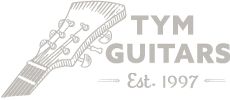1966 Teisco WG-4L
Share
Following on from the earlier version blog before this slightly later version of the great WG-4L features the striped aluminium scratchplate which was introduced in late '64 and famous 4/2 headstock which was intermittently introduced in late '64 with several older Teisco headstock shapes still being used by mid '65.
These features are probably the most recognisable features of Teisco guitars.
This shape had been running since 1964 and in early '66 Teisco introduced the K series guitars with sleek and beautiful body shapes with opposite pointing horns. The new sleek Teiscos became a big hit overseas and in Japan and range expanded quickly during the beginning of the boom.

Teisco were now making aesthetically more adventurous and better quality guitars and the WG series seemed slightly clunky in comparison so these weren't exported in large numbers as the big Japanese brands were keen to show off their new and exciting models.
The WG was still selling well in Japan and it was kept in the line until the Kawai takeover in '67.

These are great guitars when they're set up properly and those pickups, and options for selection are amazing. They're such a full sounding pickup and sound great in any position, including all four.
The necks are still a little rudimentary with a thick but comfortable feel. I'm a "small neck" guy (Mosrites) but these really do start feeling good quite quickly and they're easy to play. The frets are small (which I also like) but don't hinder playing lead at all.

The metal hardware is all good quality and apart from the usual pitting, all still worked well. This one has the later vibrato which is a very efficient and smooth unit. The quality of materials, design and workpersonship on these older Japanese guitars were amazing for the price. As I've said in previous blogs, this is all original at 50 years old, and still functions really well for what it was designed for.

This one has some knocks and player wear. It's been used, which is nice. There's a bit of paint missing and the vibrato arm is gone and replaced with a Bigsby style arm, but all the electrics, including all switches are original and working.

This would have had the round Teisco logo badge on the headstock introduced in '65 but unfortunately, it's long gone as is common on these.
Teisco would go on to make some of my favourite guitars but I still have a real fondness for these slightly more primitive designs. They lie between the early late 50's period of basic solidbody Japanese guitars and the slightly later adventurous designs.








